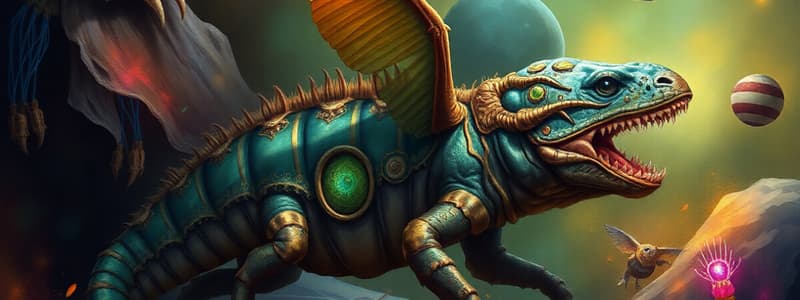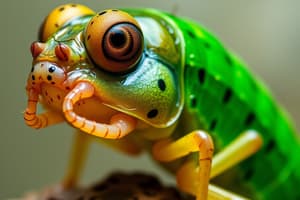Podcast
Questions and Answers
What characteristic is NOT found in mammals?
What characteristic is NOT found in mammals?
- They are warm-blooded.
- They have mammary glands.
- They lay eggs with hard shells. (correct)
- They have a completely divided four-chambered heart.
Which of the following is a common feature of the Aves group?
Which of the following is a common feature of the Aves group?
- Respiration through gills.
- Live birth of young.
- Two pairs of limbs.
- Body covered with feathers. (correct)
Which animal is NOT a member of the Mammalia group?
Which animal is NOT a member of the Mammalia group?
- Lizard (correct)
- Kangaroo
- Lion
- Rat
What adaptation is specifically associated with the Aves for flight?
What adaptation is specifically associated with the Aves for flight?
Which of the following is TRUE about reptiles excluding snakes?
Which of the following is TRUE about reptiles excluding snakes?
What distinguishes vertebrates from invertebrates?
What distinguishes vertebrates from invertebrates?
Which phylum includes pore-bearing animals?
Which phylum includes pore-bearing animals?
Which of the following is true about invertebrates?
Which of the following is true about invertebrates?
Echinodermata primarily use which structure for locomotion?
Echinodermata primarily use which structure for locomotion?
What type of body organization do poriferans exhibit?
What type of body organization do poriferans exhibit?
How many major phyla do invertebrates comprise?
How many major phyla do invertebrates comprise?
Which group of animals does not possess appendages for movement?
Which group of animals does not possess appendages for movement?
Which of the following is NOT a characteristic of Echinodermata?
Which of the following is NOT a characteristic of Echinodermata?
What defines vertebrates in terms of their organ systems?
What defines vertebrates in terms of their organ systems?
Which respiratory organ is primarily used by Pisces?
Which respiratory organ is primarily used by Pisces?
What is a characteristic feature of annelids?
What is a characteristic feature of annelids?
What type of circulatory system do arthropods have?
What type of circulatory system do arthropods have?
Which of the following groups includes animals that breathe through skin?
Which of the following groups includes animals that breathe through skin?
What is the primary body segmentation of arthropods?
What is the primary body segmentation of arthropods?
Which subgroup of vertebrates has the simplest level of body organization?
Which subgroup of vertebrates has the simplest level of body organization?
What does the term 'triploblastic' refer to in animal classification?
What does the term 'triploblastic' refer to in animal classification?
What term describes the body arrangement of flatworms?
What term describes the body arrangement of flatworms?
Which of the following is an example of an endoparasitic flatworm?
Which of the following is an example of an endoparasitic flatworm?
What characteristic differentiates Nemathelminthes from Platyhelminthes?
What characteristic differentiates Nemathelminthes from Platyhelminthes?
What type of body cavity do Cnidaria possess?
What type of body cavity do Cnidaria possess?
Which of the following statements is true about reptiles?
Which of the following statements is true about reptiles?
What defines the body organization of Cnidarians?
What defines the body organization of Cnidarians?
Which type of worm is NOT classified as an endoparasite?
Which type of worm is NOT classified as an endoparasite?
What type of organisms are considered triploblastic?
What type of organisms are considered triploblastic?
Flashcards
Kingdom Animalia
Kingdom Animalia
The kingdom comprising all animals, both invertebrates and vertebrates, showcasing evolutionary complexity.
Invertebrates
Invertebrates
Animals without a backbone, classified into eight major phyla based on complexity.
Vertebrates
Vertebrates
Animals with a backbone, classified into five major groups, higher on the evolutionary tree.
Phylum Porifera
Phylum Porifera
Signup and view all the flashcards
Cellular level of organization
Cellular level of organization
Signup and view all the flashcards
Phylum Echinodermata
Phylum Echinodermata
Signup and view all the flashcards
Tube feet
Tube feet
Signup and view all the flashcards
Coelom
Coelom
Signup and view all the flashcards
Platyhelminthes
Platyhelminthes
Signup and view all the flashcards
Triploblastic
Triploblastic
Signup and view all the flashcards
Endoparasites
Endoparasites
Signup and view all the flashcards
Tapeworm
Tapeworm
Signup and view all the flashcards
Nemathelminthes
Nemathelminthes
Signup and view all the flashcards
Diploblastic
Diploblastic
Signup and view all the flashcards
Cnidaria
Cnidaria
Signup and view all the flashcards
Reptilia
Reptilia
Signup and view all the flashcards
Pisces
Pisces
Signup and view all the flashcards
Annelida
Annelida
Signup and view all the flashcards
Haemolymph
Haemolymph
Signup and view all the flashcards
Excretion in Annelida
Excretion in Annelida
Signup and view all the flashcards
Arthropoda
Arthropoda
Signup and view all the flashcards
Respiration in vertebrates
Respiration in vertebrates
Signup and view all the flashcards
Limbs for locomotion
Limbs for locomotion
Signup and view all the flashcards
Characteristics of Aves
Characteristics of Aves
Signup and view all the flashcards
Adaptations of Mammalia
Adaptations of Mammalia
Signup and view all the flashcards
Respiration in Aves and Mammalia
Respiration in Aves and Mammalia
Signup and view all the flashcards
Examples of Mammals
Examples of Mammals
Signup and view all the flashcards
Study Notes
Animal Kingdoms: Invertebrates and Vertebrates
- Kingdom Animalia is broadly classified into Invertebrates and Vertebrates, based on the presence or absence of a vertebral column (backbone).
- Invertebrates lack a backbone.
- Vertebrates possess a backbone.
- Invertebrates are further grouped into eight phyla.
- Vertebrates are divided into five major groups: Pisces, Amphibia, Reptilia, Aves, and Mammalia.
- Invertebrates show a simpler body organization than vertebrates.
Invertebrates: Eight Major Phyla
- Porifera (pore-bearing animals): Simplest multicellular animals; their bodies are made up of loosely connected cells that perform life functions independently. They have no tissues, organs, or organ systems. Examples include sponges (Euspongia and Sycon).
- Cnidaria (hollow sac-like animals): Possess a hollow body cavity with one opening (the mouth). Their bodies are made up of two cell layers and have basic tissue level organization. Examples include hydra, jellyfish, and sea anemones.
- Platyhelminthes (flat worms): Ribbon-like or leaf-like, thin, flat bodies, no body cavity, triploblastic animals. Many are parasites. Examples include tapeworms and liver flukes.
- Nemathelminthes (threadworms or roundworms): Small, thread-like, unsegmented bodies, triploblastic animals. Many are parasites and found in various environments. Examples include ascaris, pinworms, and filarial worms.
- Annelida (segmented worms): Body divided into segments, soft bodies, triploblastic, have a body cavity, basic organ systems. Examples include earthworms and leeches.
- Arthropoda (animals with jointed legs): Largest group, bodies are segmented, have a body cavity (haemocoel), have organ systems, which are often primitive. Examples of Arthropods Include insects, arachnids, crustaceans, etc.
- Echinodermata (spiny skinned animals): Beautiful marine animals with rough, spiny, and star-like, disc-like, or flower-like bodies. They have a true coelom, a body cavity, with a network of fluid filled canals that facilitate gas exchange, locomotion, and feeding. Move using tube feet to help in feeding and respiration. Examples include starfish, sea urchins, and brittle stars.
Vertebrates: Five Major Groups
- Pisces (fishes): Aquatic animals with gills for respiration, two chambered hearts, scales, fins for locomotion. Water-dwelling, cold-blooded. Examples include Rohu, tuna, sharks, and seahorses.
- Amphibia (amphibians): Live in both water and land. Undergo metamorphosis from aquatic larvae (tadpole) to terrestrial adult. Lungs and limbs develop; three chambered heart; cold-blooded. Examples include frogs, toads, and salamanders.
- Reptilia (reptiles): Adapted for life on dry land. Lay eggs on land. Partially divided four-chambered heart. Dry, scaly skin. Lungs for respiration. Cold-blooded. Examples include turtles, lizards, crocodiles, snakes, and chameleons.
- Aves (birds): Adapted for flight. Hollow bones for lightness, feathers, modified forelimbs (wings), four chambered heart, warm-blooded, lay hard-shelled eggs. Examples include hen, sparrow, eagle, peacock, ostrich.
- Mammalia (mammals): Live on land, majority are terrestrial (some are aquatic). Warm-blooded. Give birth to live young. Mammary glands nourish young ones. Have four-chambered hearts and lungs. Examples include rats, kangaroos, lions, deer, humans.
Studying That Suits You
Use AI to generate personalized quizzes and flashcards to suit your learning preferences.




